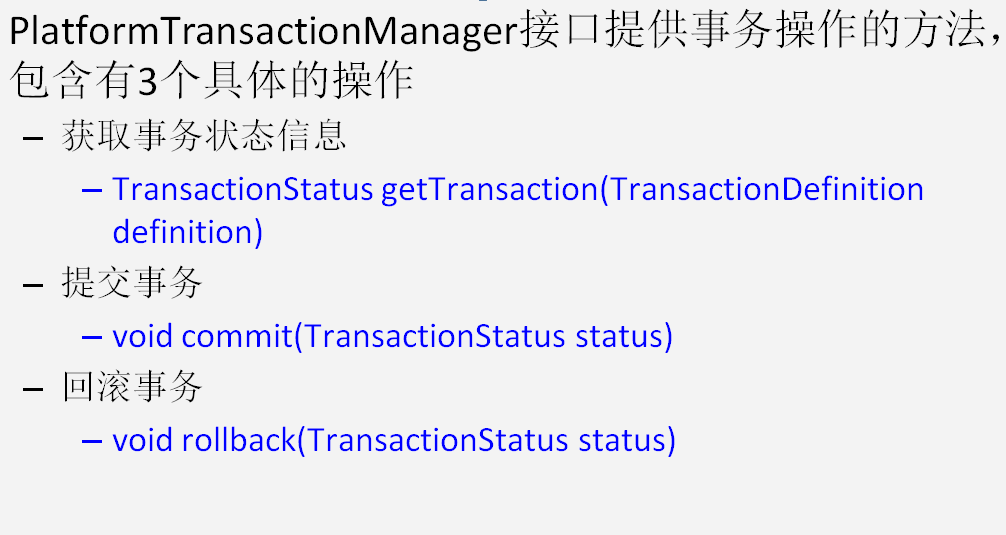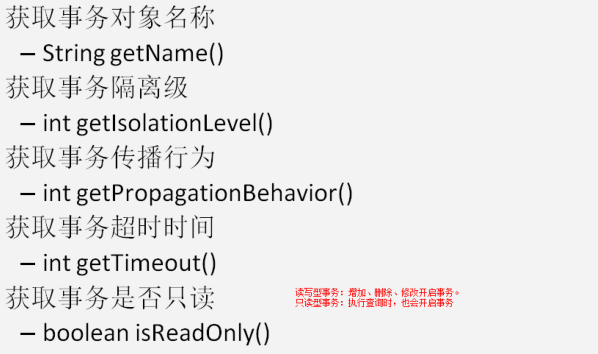JavaEE 体系进行分层开发,事务处理位于业务层,Spring 提供了分层设计业务层的事务处理解决方案。
spring 框架为我们提供了一组事务控制的接口,这组接口是在spring-tx-x.x.x.RELEASE.jar 中。
spring 的事务控制都是基于 AOP 的,它既可以使用编程的方式实现,也可以使用配置的方式实现。
Spring 中事务控制的 API 介绍
PlatformTransactionManager:此接口是 spring 的事务管理器,它里面提供了常用的操作事务的方法

在开发中都是使用它的实现类:
真正管理事务的对象
org.springframework.jdbc.datasource.DataSourceTransactionManager 使用 Spring JDBC 或 iBatis 进行持久化数据时使用
org.springframework.orm.hibernate5.HibernateTransactionManager 使用 Hibernate 进行持久化数据时使用
TransactionDefinition:事务的定义信息对象

事务的隔离级别

事务的传播行为:
REQUIRED:如果当前没有事务,就新建一个事务,如果已经存在一个事务中,加入到这个事务中。一般的选择(默认值)
SUPPORTS:支持当前事务,如果当前没有事务,就以非事务方式执行(没有事务)
MANDATORY:使用当前的事务,如果当前没有事务,就抛出异常
REQUERS_NEW:新建事务,如果当前在事务中,把当前事务挂起。
NOT_SUPPORTED:以非事务方式执行操作,如果当前存在事务,就把当前事务挂起
NEVER:以非事务方式运行,如果当前存在事务,抛出异常
NESTED:如果当前存在事务,则在嵌套事务内执行。如果当前没有事务,则执行 REQUIRED 类似的操作。
超时时间:
默认值是-1,没有超时限制。如果有,以秒为单位进行设置。
是否是只读事务:
建议查询时设置为只读。
TransactionStatus:此接口提供的是事务具体的运行状态

基于 XML 的声明式事务控制(配置方式 )
1.导入需要的坐标
<dependency> <groupId>org.springframework</groupId> <artifactId>spring-jdbc</artifactId> <version>5.0.2.RELEASE</version> </dependency> <dependency> <groupId>org.springframework</groupId> <artifactId>spring-tx</artifactId> <version>5.0.2.RELEASE</version> </dependency> <dependency> <groupId>org.aspectj</groupId> <artifactId>aspectjweaver</artifactId> <version>1.8.7</version> </dependency>
2.创建 spring 的配置文件并导入约束,需要导入 aop 和 tx 两个名称空间
<?xml version="1.0" encoding="UTF-8"?> <beans xmlns="http://www.springframework.org/schema/beans" xmlns:xsi="http://www.w3.org/2001/XMLSchema-instance" xmlns:aop="http://www.springframework.org/schema/aop" xmlns:tx="http://www.springframework.org/schema/tx" xsi:schemaLocation="http://www.springframework.org/schema/beans http://www.springframework.org/schema/beans/spring-beans.xsd http://www.springframework.org/schema/tx http://www.springframework.org/schema/tx/spring-tx.xsd http://www.springframework.org/schema/aop http://www.springframework.org/schema/aop/spring-aop.xsd"> </beans>
3.配置事务步骤
第一步:配置事务管理器
<!-- 配置一个事务管理器 --> <bean id="transactionManager" class="org.springframework.jdbc.datasource.DataSourceTransactionManager"> <!-- 注入 DataSource --> <property name="dataSource" ref="dataSource"></property> </bean>
第二步:配置事务的通知引用事务管理器
<!-- 事务的配置 --> <tx:advice id="txAdvice" transaction-manager="transactionManager"> </tx:advice>
第三步:配置事务的属性
<!--在 tx:advice 标签内部 配置事务的属性 --> <tx:attributes> <!-- 指定方法名称:是业务核心方法 read-only:是否是只读事务。默认 false,不只读。 isolation:指定事务的隔离级别。默认值是使用数据库的默认隔离级别。 propagation:指定事务的传播行为。 timeout:指定超时时间。默认值为:-1。永不超时。 rollback-for:用于指定一个异常,当执行产生该异常时,事务回滚。产生其他异常,事务不回滚。 没有默认值,任何异常都回滚。 no-rollback-for:用于指定一个异常,当产生该异常时,事务不回滚,产生其他异常时,事务回滚。 没有默认值,任何异常都回滚。 --> <tx:method name="*" read-only="false" propagation="REQUIRED"/> <tx:method name="find*" read-only="true" propagation="SUPPORTS"/> </tx:attributes>
第四步:配置 AOP 切入点表达式
<!-- 配置 aop --> <aop:config> <!-- 配置切入点表达式 --> <aop:pointcut expression="execution(* com.fgy.service.impl.*.*(..))" id="pt1"/> </aop:config>
第五步:配置切入点表达式和事务通知的对应关系
<!-- 在 aop:config 标签内部:建立事务的通知和切入点表达式的关系 --> <aop:advisor advice-ref="txAdvice" pointcut-ref="pt1"/>
基于注解的配置:
1.导入需要的坐标
......
2.创建 spring 的配置文件导入约束并配置扫描的包
<?xml version="1.0" encoding="UTF-8"?> <beans xmlns="http://www.springframework.org/schema/beans" xmlns:aop="http://www.springframework.org/schema/aop" xmlns:tx="http://www.springframework.org/schema/tx" xmlns:context="http://www.springframework.org/schema/context" xmlns:xsi="http://www.w3.org/2001/XMLSchema-instance" xsi:schemaLocation=" http://www.springframework.org/schema/beans http://www.springframework.org/schema/beans/spring-beans.xsd http://www.springframework.org/schema/aop http://www.springframework.org/schema/aop/spring-aop.xsd http://www.springframework.org/schema/tx http://www.springframework.org/schema/tx/spring-tx.xsd http://www.springframework.org/schema/context http://www.springframework.org/schema/context/spring-context.xsd"> <!-- 配置 spring 创建容器时要扫描的包 --> <context:component-scan base-package="com.fgy"></context:component-scan> </beans>
3.配置步骤
第一步:配置事务管理器,并注入数据源
<!-- 配置事务管理器 --> <bean id="transactionManager" class="org.springframework.jdbc.datasource.DataSourceTransactionManager"> <property name="dataSource" ref="dataSource"></property> </bean>
第二步:在业务层使用 @Transactional 注解
@Service("accountService")
@Transactional(readOnly=true,propagation=Propagation.SUPPORTS)
public class AccountServiceImpl implements IAccountService {
@Autowired
private IAccountDao accountDao;
@Override
public Account findAccountById(Integer id) {
return accountDao.findAccountById(id);
}
@Override
@Transactional(readOnly=false,propagation=Propagation.REQUIRED)
public void transfer(String sourceName, String targeName, Float money) {
//1.根据名称查询两个账户
Account source = accountDao.findAccountByName(sourceName);
Account target = accountDao.findAccountByName(targeName);
//2.修改两个账户的金额
source.setMoney(source.getMoney()-money);//转出账户减钱
target.setMoney(target.getMoney()+money);//转入账户加钱
//3.更新两个账户
accountDao.updateAccount(source);
//int i=1/0;
accountDao.updateAccount(target);
}
}
该注解的属性和 xml 中的属性含义一致。该注解可以出现在接口上,类上和方法上。
出现接口上,表示该接口的所有实现类都有事务支持。
出现在类上,表示类中所有方法有事务支持
出现在方法上,表示方法有事务支持。
以上三个位置的优先级:方法 > 类 > 接口
第三步:在配置文件中开启 spring 对注解事务的支持
<!-- 开启 spring 对注解事务的支持 --> <tx:annotation-driven transaction-manager="transactionManager"/>
完全不使用 xml 的配置方式
@Configuration @EnableTransactionManagement public class SpringTxConfiguration { //里面配置数据源,配置 JdbcTemplate,配置事务管理器。 }
@TransactionalEventListener 注解使用:https://www.jianshu.com/p/88b76e870c63